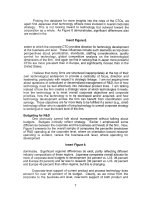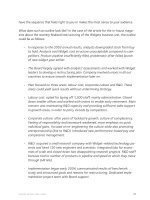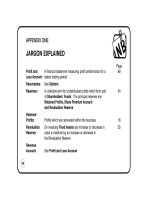you can pass the cpa exam get motivate phần 10 pot
Bạn đang xem bản rút gọn của tài liệu. Xem và tải ngay bản đầy đủ của tài liệu tại đây (256.14 KB, 38 trang )
There are several basic areas of training that must be provided for the people
involved in the project management process, which may include the following.
General Skills for Project Managers (and Key Players)
• Presentation skills. • Leadership skills.
• Communication skills. • Stress management.
• Team building. • Time management.
• Decision making. • Organization and management theory.
• Problem solving.
Corporate-Specific Practices
• Understanding the organization.
• Operating practices and procedures.
• Specific roles and responsibilities.
General Project Management Knowledge
• Principles and practices of project management.
• What does project management software do.
• Estimating, proposals, and project initiation.
• Techniques for project planning.
• Role of the project manager.
Using the Project Management Software (PMS)
• Basic computer training.
• Basic PMS training.
• Using the PMS for your applications.
• Application-specific formats and procedures.
• System interfaces.
Tip Training should be designed to meet the specific needs
to the trainee. This will require multifaceted, multilevel train-
ing sessions, aimed at a target audience. The project manage-
ment system should be designed to recognize the role of each
user, especially in regard to input forms, output forms, and in-
cluded data. The training sessions should pick up on these
specifics and show how the system is designed for each user in
the audience, and how it will be used by each.
340 IMPLEMENTING PROJECT MANAGEMENT
TEAMFLY
Team-Fly
®
Are These Really Necessary?
Are all the above recommendations really required for the successful implemen-
tation of a computer-based project management capability? It is dangerous to
take for granted that your people have any of these skills, or that your objectives
will be met without them. Every time I have been called into a company to fix a
project management software application, I have found that the majority of the
problems were not directly attributed to the software itself. They nearly always
fell into the categories listed above: lack of commitment, poorly defined roles and
responsibilities, lack of essential skills, and misunderstanding of what the project
management software does.
Trap Here is something that I can state with absolute cer-
tainty. It is entirely impossible to implement a computer-based
project management capability without also implementing a
broad, multilevel training program. Even if the computer plays
a small role in your project management process, an under-
standing of the principles of project management and the lo-
cal practices that have been put in place cannot be taken for
granted. A formal training effort is required to prevent failure
of the project management initiative.
Do You Really Want Success?
Some time ago, I was called in to help a well-respected NASA component that
was experiencing problems with its project management software application. It
seems that the plan being presented by the system was not reflecting the actual
plan as desired by the project manager. Furthermore, reports being produced by
the system were not getting the desired results.
Upon interviewing the participants in this process, I found two underlying
problems. First, there was a widespread lack of knowledge about what the sys-
tem did, and especially of what was done with the plans and data they entered
into the system. Second, the framework (work breakdown structure) that was
established within the system did not reflect the actual working breakdown
used by the people who were planning their work. It wasn’t really their fault.
No one had bothered to provide an orientation on these principles. So how was
anyone to know?
Even if the system had been outputting accurate and consistent planning in-
formation, it would have been lost on those who were targeted for the output.
DO YOU REALLY WANT SUCCESS? 341
First, the system operators had failed to design good reports. They needed to
identify who the project decision makers were, and what kind of information they
needed to support that responsibility. Then, they should have designed specific
reports for each, containing the records that were appropriate to their action area.
The reports should have been sorted in the most effective manner to facilitate
analysis of the data and limited to the data elements needed to support their ex-
pected response.
No one had bothered to indoctrinate the recipients of these data. You have to
tell people how to read the reports and how to interpret the data. They need to
know how to identify an out-of-tolerance condition, and what is expected of them
in the way of a response.
In the case just illustrated, the situation was completely turned around by pre-
senting two half-day workshops. As a result, the framework was changed, the in-
put data was reconfigured to support the CPM process being employed, and the
reports were redesigned to support the needs of the intended recipients. The par-
ticipants were now able to understand how the process worked and what their
role was in the process.
Heading for Success
Getting back to my experience with the company that I felt was proceeding
with a worthy program to implement project management, here is what they
were doing:
1. An individual was assigned responsibility to lead in the design of the appli-
cation, including system interfaces and configuration.
2. That individual also set up standards and templates for using the selected
project management software product. Although system users get prod-
uct training, they do not have to design their own reports, forms, tables,
or filters.
3. A multifaceted training program was implemented. This included:
• A two-day series of lectures and workshops on the general skills that are
useful in the project environment.
• A one-day seminar and workshop on the principles and practices of proj-
ect management, including roles and responsibilities, and project initia-
tion techniques. The workshop was customized for the client by having
the consultant precede that effort with a day of interviewing and examin-
ing the company’s methods and program.
• A two-day seminar in using the project management software.
342 IMPLEMENTING PROJECT MANAGEMENT
It would appear that this firm has demonstrated the level of commitment
essential to the successful implementation of the computer-based project
management capability. And they have backed it up with a comprehensive
indoctrination/training program.
Training and Commitment Make the Difference
The message here is a simple one. If you are going to invest in an improved proj-
ect management capability, you should back that investment up with the training
and commitment that are essential to make that investment pay off. A compro-
mise in this area is very likely to lead to total failure of the effort.
TRAINING AND COMMITMENT 343
CHAPTER 13.2
MAKING PROJECT COMMUNICATION WORK
Everything You Need to Know
about Project Communication
344
I
n real estate, it’s “location, location, location.” When it comes to project suc-
cess, the three most important factors are: “communication, communication,
communication.”
Throughout the entire life cycle of the project, it is communication that en-
ables the flow and transfer of knowledge that is essential to project success. In
its earliest stages, it is communication that is the amniotic fluid that sustains the
emerging project and brings the project to life. During the sensitive planning
stages, it is communication that brings out ideas and builds to consensus. Dur-
ing the project execution phase, it is communication that supports and reports
progress, and facilitates corrective action and management decisions as needed.
And at the conclusion of the project, it is communication that spreads the word
about the success of the project and records the knowledge gained and lessons
learned.
Tip When properly handled, good, effective, timely, appro-
priate communication can have an important role in achieving
project success. On the other hand, poor, haphazard, incom-
plete, untimely, and misdirected communication is a recipe for
project failure.
If we review the reasons why we communicate, we should easily see its
importance.
Why We Communicate
Discuss Objectives and Strategies
Perhaps this is the most important communication of them all. This is where we
collect ideas as to the best ways to achieve the project objectives and to avoid pit-
falls. Here is where we start to build project consensus and develop buy-in by the
project stakeholders.
Disseminate Project Guidelines
Once the project objectives, constraints, and strategies have been defined, it is im-
portant that the project participants all get on the same track. This requires leader-
ship and guidance. It requires that these key data be broadcast to the project
participants and that it be made clear that these guidelines are be followed by all.
This can be accomplished by the issuance of a Project Charter. The practice of
having Project Charters as the defining guideline is a key factor in achieving suc-
cessful projects. The Project Charter will have signature approvals by senior man-
agers, as a sign of authorization to proceed and demand for support.
Collect Project Plan Inputs
The Project Charter becomes the basis for building a Project Plan. It is a commu-
nication vehicle to collect plan inputs from all the project contributors. Very early
in this planning stage, the team should create a Project Milestone Schedule
(PMS) and a Work Breakdown Structure (WBS).
The PMS serves as a guideline for building a schedule. It contains the project
start and end dates and key interim dates. It notes important milestones, contract
commitments, and constraints. It communicates the preferred (or required) peri-
ods for each project phase. Ordinarily, if the project contributors can commit
their support for work within the defined periods on the PMS, it minimizes the
necessity to micromanage the schedule.
The WBS serves as a guideline for defining and organizing the workscope. It
provides a checklist for selecting the work items that make up the project. It pro-
vides a structure for assigning responsibilities, and its hierarchical form facilitates
summarization, selection (filtering), and sorting of the project work items for re-
porting. The WBS is also used for earned value and performance analysis.
WHY WE COMMUNICATE 345
Build Baseline Plan
The Baseline Plan is the convergence of the definition of the workscope, the
schedule, the assignment of resources, and the project budget. Achieving objec-
tives in each of these areas often precedes meeting the objectives in other areas.
So the establishment of a Baseline Plan may involve negotiation and adjustment to
find the best balance in each area. Obviously, this is a major communication event.
Obtain Commitments
Even the best project plan, diligently developed by the project team, will fail un-
less the team can get widespread buy-in from the participants and a commitment
to do whatever is necessary to meet targets and obligations. The team must be
sure to have communicated these targets and to have made clear the conse-
quences of deficient support.
Communicate Baseline Plan
Support for the plan cannot be expected if it is not communicated. Communicat-
ing the baseline plan means more than circulating a document. The plan and
everyone’s role in that plan must be fully understood. Responsibilities for manag-
ing and performing the work must be clear. A traditional weak spot is the inter-
face where performance or management of work is transferred to other people.
These areas should receive special attention to be sure that the people involved
will communicate status and transfer data, and that they clearly understand the
nature of the interface.
Again, senior management should indicate approval of the baseline plan and
approval to move to the project execution phase.
Gather Project Progress Data
Gathering progress information is getting easier and easier with today’s advanced
computer-based systems. We have the ability to generate automatic notifications
of events, changes, and accomplishments. Our systems can now communicate
over direct, hardwired links, via facsimile transmission, by e-mail, and so on. In-
formation is now available in real time. We have electronic timesheets, and auto-
mated routines for approval or rejection.
There is no excuse for failing to collect timely and accurate progress data. Yet,
there is still a great possibility for grossly erroneous data unless the communica-
tion of such data has human intervention.
346 MAKING PROJECT COMMUNICATION WORK
The project team should designate someone to facilitate the dissemination of
progress information and the retrieval of progress data from the participants. This
individual(s) shall review all progress data and check it for validity. Communica-
tion, at this point, is more in the nature of mentoring and providing assistance to
participants so that they understand what kind of progress reporting is needed
and expected.
Report Project Status
This is an area where a little creative thinking can produce very productive results.
We need to discard the old approach, wherein we produced voluminous pages of
insipid data, which was distributed to all involved parties. This generally led to the
reports accumulating dust in a far corner of the office, or taking up valuable space
on the hard drive. It was usually too much data and not enough information.
First of all, the capability exists to customize project status reports so that each
participant receives information that is tailored to his or her specific need. The data
may be detailed or summarized, depending on need. The data can be selective, pro-
viding detail over a narrow band, or at a higher level of detail for a wider span of in-
terest. Data can be restricted to a particular area, such as schedule, cost, or resource
utilization. It can focus on accomplishments, performance, and problems.
The key to success in this communication area is to consider each targeted re-
cipient, individually. If we can determine what each person is going to do with the
information, we can tailor the reports to serve that purpose. We need to consider
what type of decisions are to be made on the basis of the information, and design
the communication to provide what is needed, in the format that is needed, and
in the detail that is needed.
Trap There is a tendency to employ a one-size-fits-all philos-
ophy when designing input screens and reporting formats.
This will encourage resistance to support of the system by the
target users, and cannot be justified in light of the capabilities
of today’s PM tools.
We need to provide more than just data, but real information about the signif-
icance of the data. Where corrective action is indicated, we should (where feasi-
ble) provide information about effect and alternatives.
The Project Progress Reporting function will also serve to support the
following:
WHY WE COMMUNICATE 347
• Report out-of-tolerance situations.
• Request or report scope changes.
• Facilitate corrective action.
Keys to Effective Communication
The project manager is at the center of project communications. The project
manager must ensure that all communication needs, both formal and informal,
are fulfilled. The project manager must always look for and close gaps in under-
standing and communication, between all participants and interested parties, and
between all work items. The project manager is a bridge.
• Communication and measurement bases must be consistent from period
to period.
• Schedule, resource, and cost information must be synchronized.
Project Phases and Communications
A lot of information can be processed during the project. These will change as we
move through each phase of the project. As a guide, here is an example of items
that can be communicated for each phase of the project.
Project Development and Initiation
• Workscope.
• Organization.
• Stakeholder Analysis and Strategy.
• Objectives and Constraints.
• Milestones.
• Budget.
Project Planning
• Task Identification.
• Task Estimates (time and resource).
• Constraints.
• Resource Availability.
• Resource Assignments.
• Baseline Plan (schedule, resource plan, costs).
348 MAKING PROJECT COMMUNICATION WORK
Project Execution
• Work Status.
• Hours Expended or Charged.
• Actual Costs.
• Performance.
• Scope Changes.
• Corrective Action and Replanning.
Closeout/Termination
• Punch List (What/Who/When).
• Personnel Reports and Recognition Letters.
• Project Historical Data.
• Project Post-mortem Analysis and Report.
Communication Targets
Information should be tailored to maximize the usefulness and impact for each
information target. For example, here are some of the categories of people with
whom we communicate project information.
• The Project Manager and Project/SubProject Leaders.
• The Functional Managers.
• Individual Contributors.
• Suppliers (Materials and Resources).
• Senior Management.
• The Client/Sponsor/User.
Communication Categories
There are several classifications of project information. Some of this is input
data, and some represents the results of processing the inputs. Interest in these
various communication categories will differ among the project stakeholders.
Some categories are:
• Schedule Information.
• Resource and Cost Information.
• Workscope Information.
• Integrated Information.
• Baseline or Target Plan.
COMMUNICATION CATEGORIES 349
• Progress and Status.
• Performance Evaluation.
• Exceptions (out of acceptance range).
• Turn-around Data (for statusing).
Types of Communication Information
There are also differences in the level of detail and the formats of the informa-
tion. Again, just which type is appropriate will depend on the role and needs of
the target audience. Effective communication will be achieved by limiting the
communications to the most appropriate formats, rather than bombarding peo-
ple with the full warehouse of project data. An advantage of accessing data via
computer screen retrievals (today’s most popular mode) is that the user can go to
the most favored format, but then drill-down or summarize up to see either
more details or a wider picture, or a different format. Key traditional informa-
tion formats include:
• Detailed (inclusive).
• Detailed (by exception—by distribution).
• Summary.
• Narrative Analysis.
• Corrective Action and Replanning.
Information Formats
Whether detailed or summarized, whether inputs or outputs, whether hard copy
or screen based, the information will fall into these traditional formats.
Tabular
• Typical: Rows for records; columns for data fields.
• Matrix: Select two sets of data (i.e., Resource/Cost vs. Time).
Graphic
• Gantt Chart Schedule (bar chart).
• Network Diagram (PERT chart).
• Time-scaled Network or Linked Gantt.
• Resource and Cost Histograms—incremental or cumulative.
• Performance Curves (Earned Value).
350 MAKING PROJECT COMMUNICATION WORK
TEAMFLY
Team-Fly
®
Narrative
• Usually combined with one or more of the preceding, to discuss progress
and issues.
Report Variables
Here are some of the items that should be addressed when we design our reports.
• Subject. • Formats.
• Purpose. • Time Scale and Time Span.
• Distribution. • Summarization Criteria.
• Data Items (fields). • Subtotals.
• Selection Criteria (records). • What is the reader supposed to be looking for?
• Sorting Criteria. • What is the expected response?
Project Portfolio Management and Communication
All the preceding discussion was directed toward communication on a single proj-
ect. Most of us contribute to or manage multiple projects, which necessitates ad-
ditional considerations for communication.
Most of the preceding comments can also apply to the multiproject environ-
ment. Here are a few additional considerations.
• Resource-oriented data, especially in formats designed to obtain timesheet
data, should cover all projects that involve the target personnel.
• Performance data may cover multiple projects so that the performance at-
tributed to groups involved in multiple projects can be fully evaluated.
• Milestone-level data for multiple projects can be tracked in combined for-
mats, for comparative progress and performance analysis.
• Special reports should be developed to address specific concerns involved
with managing the portfolio.
• If the firm works on projects that are similar in nature, it might be advanta-
geous to develop a standard Work Breakdown Structure, to be used for all
projects in such a group. In this case, the project becomes the second level
of the standard WBS, and the project group becomes the senior level. This
allows performance analysis and reporting to be performed across projects.
PPM AND COMMUNICATION 351
CHAPTER 13.3
WHY PROJECT MANAGEMENT
IMPLEMENTATION PROGRAMS FAIL
352
Trap The failures in implementing PM can be traced back to
this simple misconception: that we can take shortcuts with
PM—that we can treat it casually and unprofessionally—and
still have it work.
I
n my experience in working with corporate clients wishing to implement a com-
puter-based PM capability, I have found the satisfaction level to be very low.
While we can easily attribute much of this to lack of adequate participation by the
user, we can’t get off the hook that easily. We need to ask why this participation
level is so low and what we can do to improve it.
As in any other business venture, the typical consultant will experience a wide
range of success (or failure) in his various engagements. While some of the short-
falls can be attributed, at least in part, to the consultant, there are often major
failures on the part of the client. Much of this can be categorized as lack of sound
communication and/or inability to have a practical vision.
The purpose of this chapter is not so much to place blame as to share the
lessons of these experiences. “He who fails to learn from his mistakes is doomed to
repeat them.” For this chapter, I focus on engagements that involve the objective
of implementing a computer-based project management capability in organiza-
tions that did not have such a capability or had a very rudimentary system that
was deemed inadequate.
Reflecting on personal consulting experience in working with corporate clients
wishing to implement a computer-based PM capability, I often find the following
typical sequence.
1. Client expresses desire/need to know what is going on—when work is to be
done—what people are working on—what the impact of new projects are
on the firm’s resources, and so on.
2. Client wants to get people to plan their work, communicate the deliverable
dates and other project info, and control the effort (somewhere in line with
the published plans).
3. Client does not have a PM methodology in place and resists the imposition
of too much structure. Simple front-end practices, such as a project charter,
do not exist.
4. Client is unwilling to integrate key components, such as Operations, Fi-
nance, Human Resources, Projects, and Line Management.
5. Client comes up with extensive list of selection criteria for sophisticated
tool support of nonexistent practices. Makes major effort to review can-
didate products, via purchase of reports, extensive staff research, and/or
use of consultants. Invites sales presentations and proposals from several
tool vendors.
6. Client will not establish a Project Office or designate personnel as responsi-
ble for PM. Client will not establish PM as a way of life in the firm, or make
support of PM a condition of employment. Reference to PM responsibilities
does not exist in anyone’s position guide.
7. Client terminates program to implement a computer-based PM capability.
Or if client does buy a product, fails to educate users and otherwise support
the process.
8. Client determines that the failure to accomplish the goal is due to the de-
manding nature of PM and PM tools—requiring a structure and level of ef-
fort exceeding that considered to be reasonable.
In all fairness, we must admit that there is some truth in the last item. Proj-
ect Management, although based entirely on a set of common sense ap-
proaches, is structured and demanding. And even the best-of-breed in PM tools
will require some education and compliance with designed processes in order
to produce usable results. However, I do not find these demands to be unrea-
sonable. As in most other things, there is an investment required if one is to
gain the desired payoff.
WHY PM IMPLEMENTATION PROGRAMS FAIL 353
With this in mind, let’s expand the above list to see what we can do to make the
implementation of a computer-based project management capability a positive
and rewarding experience.
1. Client expresses desire/need to know what is going on—when work is to be
done—what people are working on—what the impact of new projects are
on the firm’s resources, and so on.
2. Client wants to get people to plan their work, communicate the deliverable
dates and other project info, and control the effort (somewhere in line with
the published plans).
• These two items represent the identification of the need for a com-
puter-based project management capability. There is recognition that
something is either missing or inadequate. What is important is that the
wish list be kept practical. It must be consistent with the ability to real-
istically support the desired result and it must recognize the organiza-
tional culture. True, a strong leader can bring about changes in the
culture, but I have found it to be rare for top management to go to the
wall to institute major change for the purposes of implementing mod-
ern project management.
• Change, even simple change, should be deliberate, as part of a strategy.
3. Client does not have a PM methodology in place and resists the imposition
of too much structure. Simple front-end practices, such as a project charter,
do not exist.
• The implementation of a computer-based project management capabil-
ity has two major components. The first is the identification of a project
management methodology. The automation of that methodology comes
next, but only after the first has been accomplished.
4. Client is unwilling to integrate key components, such as Operations, Fi-
nance, Human Resources, Projects, and Line Management.
• Managing projects is a subset of managing the business. The strate-
gies that drive the projects and the conditions that impact upon the
projects involve other components of the enterprise. Success cannot
be achieved without full participation and cooperation of these busi-
ness components.
5. Client comes up with extensive list of selection criteria for sophisticated
tool support of nonexistent practices. Makes major effort to review can-
didate products, via purchase of reports, extensive staff research, and/or
use of consultants. Invites sales presentations and proposals from several
tool vendors.
354 WHY PM IMPLEMENTATION PROGRAMS FAIL
• We all know that the purchase of a violin does not turn a layman into a
musician. Then how can anyone believe that the acquisition of a PM tool
would automatically position that organization to be fully PM competent,
complete with practices, policies, and procedures? No! The PM tool is ac-
quired to automate a set of PM practices. While the tool can be helpful in
clarifying the PM structure and practices, it does not actually create them.
6. Client will not establish a Project Office or designate personnel as responsi-
ble for PM. Client will not establish PM as a way of life in the firm, or make
support of PM a condition of employment. Reference to PM responsibilities
does not exist in anyone’s position guide.
• The establishment of a PM capability starts with top-down direction and
requires the full diligence and support of senior management. In spon-
soring and taking command of the PM implementation, the CEO cre-
ates an environment where PM is thoroughly integrated and ingrained
into the organization, and the staff understands their requirement to
support PM.
• PM is a special discipline. Many people can participate in PM, but only
specially trained and experienced people can be experts. PM cannot be
successful unless a central component is established and staffed with
such experts. The PM Office is a single point of policy direction and
PM mentoring. Its leadership and expertise help to make PM a success-
ful endeavor.
7. Client terminates program to implement a computer-based PM capability.
Or if client does buy a product, fails to educate users and otherwise support
the process.
• By this time, the sponsors of the PM initiative realize the full scope and
requirements of the program. If they haven’t yet made the commit-
ment, they often decide that they are not willing to make the invest-
ment in organization, policy, manpower, and procedures—as well as in
tools and training.
• If the purchase has been made, they fail to follow up with all the things
that are needed to make it work—and the initiative fails.
• A successful program to implement computer-based project manage-
ment starts with a realistic set of objectives, which are consistent with
the firm’s needs, culture, and strategies, and winds up with a supportable
commitment at all levels.
8. Client determines that the failure to accomplish the goal is due to the de-
manding nature of PM and PM tools—requiring a structure and level of ef-
fort exceeding that considered to be reasonable.
WHY PM IMPLEMENTATION PROGRAMS FAIL 355
• This is a self-fulfilling prophecy. It is not the tools that require this struc-
ture and level of effort. It is the entire program of project management
that calls for this. It is no different from any other professional disci-
pline. Whether it be engineering, finance, R&D, or manufacturing, we
expect that there will be leadership, organization, policies and practices,
and expertise. We should expect no less for PM.
• The failures in implementing PM can be traced back to this misconcep-
tion: that we can take shortcuts with PM—that we can treat it casually
and unprofessionally—and still have it work.
356 WHY PM IMPLEMENTATION PROGRAMS FAIL
CHAPTER 13.4
TEAMS, TASK FORCES, AND BUREAUCRATS
357
E
ver since people discovered structured ways of getting work done, we have
dabbled in defining better ways to organize to do work and to lead the work-
force. All through the twentieth century, we listened to arguments about central-
ization vs. decentralization. We heard discourses and criticism of the bureaucratic
form of organization, and discussion on exploitative authoritarian leadership, vs.
benevolent authoritarian leadership, vs. consultative, vs. participative.
However, even in the most structured organizations, it didn’t take long to rec-
ognize that there were certain situations that were better addressed outside the
formal, fixed structure. Yet there are always diehards, who will resist exceptions to
the very end. Take this situation, for example.
The Bureaucrats
A few years ago, I was called in by a company, an HMO, that had just been
handed a virtually unachievable deadline. The HMO had recently received gov-
ernment approval to start a new service and was in the early stages of a four-
month program to implement the new offering. Coincident to this, this HMO
announced the acquisition of another HMO agency, which was already approved
and committed to offer the new service. As a consequence, the federal program
that was approved to start in four months was now required to be operating in six
weeks. This deadline, under the best possible circumstances, would appear to be
an impossible task.
However, this HMO did not have the best possible circumstances. They oper-
ated under very rigid boundaries, within a traditional hierarchy. Each discipline
within the organization had its own director, and all practices required going
through the directors for action. The boundaries were like stone walls.
With at least four months of work to be accomplished in this six-week period, I
asked if the company had set up an emergency team, with representatives of each
stakeholder group. I was told that this company did not believe in any type of task
force arrangement, under any circumstances. When I asked how each of the
stakeholder groups communicated and coordinated their efforts in support of this
high priority program, I was told that the directors of each group met monthly.
My pressing for an exception in this instance met with total resistance.
The Task Force
I have no intention here to get into a discussion on the advantages or disadvan-
tages of a highly structured, rigid organization. But I do want to press for the ac-
ceptance of exceptions to such formal structures, when a situation such as the one
just described arises. In the example, surely a task force approach is almost
mandatory. In this case, I would have had the Manager of Senior Services (the
critical stakeholder) head a team of representatives of each contributing depart-
ment. These representatives would be authorized to make decisions for their dis-
cipline (following procedures that were set up by the director of each
department). They would be dedicated to the special project to whatever level of
effort was required to accomplish the goal.
The task force would meet frequently (at least once a week) to communicate
results and resolve outstanding concerns. The task force members would com-
municate with other contributors from their discipline and coordinate their ef-
forts. At the initial task force meeting, the team would develop a project plan
and would disseminate the plan and obtain supporting commitments from mem-
bers of their department. The task force leader would be able to communicate
freely with the task force members and establish commitments and program re-
sults without having to go through the department directors, or to wait for a
monthly meeting.
Although this is a significant deviation from the rigid structure that was in
place in this organization, the use of a task force in this situation should not be
looked at as an attack on the establishment. It is a temporary organization,
formed for a specific objective. When the goal has been met, everything re-
turns to normal.
358 TEAMS, TASK FORCES, AND BUREAUCRATS
Trap Rigid organizational structures can prevent the firm
from a prompt and appropriate response to a crisis or critical
deadline. All organizations must be able to establish tempo-
rary teams or task forces to respond to such situations.
Success Stories
The task force model can work for the most varied situations. Here are three
case histories where the task force or special team approach proved to be very
successful.
Case 1—Design Crisis
As a designer of nuclear propulsion systems for the United States Navy, this orga-
nization was involved in overseeing the design and manufacture of the core for a
shipboard nuclear reactor. This element was one of thousands of critical compo-
nents being built for a prototype vessel, to a tight schedule. Suddenly, the manu-
facturing contractor discovered that the intended method for welding the fuel
elements was not going to work, putting the entire program on hold for this criti-
cal component.
Immediately, a task force was established, with representatives of all the con-
cerned groups within the organization. The task force leader—a department
head—called the team together and led in the development of a 13-week sched-
ule to resolve the problem. Weekly meetings were held—not to hear any excuses
of delays or failure—but only to communicate results. The schedule was refined
only once, during the first week, and was then frozen. Everyone shared the sense
of commitment and produced as was expected and required. At the end of the 13
weeks, the desired remedy was achieved and the program moved forward.
It is doubtful that this kind of commitment, cooperation, and execution would
have been achieved within the normal, day-to-day operations of the organization.
In this task force mode, the team was able to focus on the critical problem, some-
what free of conflicts with other obligations. The high priority of the task force as-
signment was clear and effective.
Case 2—Strategic Plan
An Engineering–Design organization was asked to develop a strategic plan. The
organization was to: (1) identify areas of expertise and opportunity; (2) identify
what was needed to build expertise to position the organization as first or second
SUCCESS STORIES 359
(in business performance) in five selected capability areas; and (3) to develop a
plan to prioritize and excel in these five selected areas.
A strategic planning team was called together for this purpose. Although the
primary membership in this team was engineering and design managers, the
team leader was actually a much lower statused individual, but one with strategic
and management planning expertise. As an example of today’s tendency to recog-
nize knowledge power as equal or superior to position power, the managers will-
ingly followed the lead of this individual as he guided the team to the successful
development of the strategic plan.
In this instance, borders were crossed and the traditional hierarchy was in-
verted. And everyone was pleased with the results. The objective was achieved,
by a group of people who had not previously been involved in developing a strate-
gic plan. The establishment of a temporary team, with a common objective,
helped to break down any of the traditional territorial defenses.
Case 3—Developing New Practices and Systems
In this case, the firm was a leader in the power generation and power delivery
equipment industry and had built a growing business in delivering turnkey power
generation solutions. However, the firm was not entirely satisfied with the results
(financial and other) of these projects. Senior management decided that the en-
tire method of managing such projects needed to be evaluated and, if found
wanting, should be replaced with improved methods.
A task force was established, made up of six individuals with expertise in the
areas associated with developing new practices and systems to support project
management. These included PM experts, finance experts, systems developers,
and training professionals. The team set out first to determine what methods
were desired to manage the turnkey projects. Having gained consensus and ap-
proval of the proposed methods, they then defined and developed the computer
systems to support the new methods. The team continued to operate as they led
in the development and execution of training programs, to indoctrinate the orga-
nization in the new methods and systems. Finally, selected members of the origi-
nal task force were engaged to audit the implementation of the new practices,
and to assist in mentoring individuals in support of the program.
The task force activities were executed over about a two-year period. All
task force members carried out other, normal activities in addition to their spe-
cial obligations to this program. For their normal activities, they reported to
and took direction from their direct managers. For the task force activities,
they were directed by a manager who was assigned to oversee the work of the
task force and to facilitate reaching organization-wide consensus and ap-
360 TEAMS, TASK FORCES, AND BUREAUCRATS
TEAMFLY
Team-Fly
®
CHAPTER 13.5
THE PSYCHOLOGICAL CONTRACT
How to Stimulate Initiative and
Innovation in Any Organization
362
T
hrough the years, arguments have persisted relative to the philosophy of peo-
ple in organizations. Knowledgeable and perceptive experts in behavioral sci-
ence repeatedly offer analyses of the ills in organizations and propose remedies
by the hundreds. These are usually fascinating dissertations. Based on formal
studies in this discipline, and extensive, personal field experience and observa-
tion, I offer some of my own thoughts on this topic.
Behavioral Studies
What a treasure trove of discoveries and prescriptions we have in the literature
of the past century. Reaching back to Frederick Taylor’s breakthrough treatise
on productivity and efficiency of men and machines, through Joseph Scanlon’s
provocative concepts of group rewards, continuing with behavioral observations
by Abraham Maslow, Frederick Herzberg, George Odiorne, Douglas MacGre-
gor, Henry Mintzberg, Herbert Simon, Chester Barnard, James March, Rensis
Likert, Elton Mayo, Henri Fayol, Theodore Levitt, Chris Argyris, and Warren
Bennis, and more recently, writings on leadership by Tom Peters, W. Edwards
Deming, Peter Drucker, and Rosabeth Moss Kanter, we are the beneficiaries of
years and years of research, reduced by these experts to a few hundred books
on organizational behavior.
Many of these are from what I call the Timex School, addressing what makes
people tick (and how to make them tick better). Many address issues regarding
the design of the organization (theoretically to promote better support by people
of the organization’s mission). Many of them treat people as chattel, as if the only
thing of importance is the organization’s mission (which is usually to increase the
return to the stockholder). Essentially, these writings fall into one of three stages
of behavioral discovery.
• Production Efficiency: Getting the most out of people while having little re-
gard for the people themselves.
• Human Behavior: Motivation, needs, and the nature of man.
• Leadership: How to use what we know about people to lead them to greater
productivity and happiness through individual performance and initiative.
In addition to the treatise on individual behavior, we are exposed to arguments
about centralization vs. decentralization. (Have you ever noticed that if a consul-
tant is called in to look at a centralized organization, he will recommend decen-
tralizing? But if called in to look at a decentralized organization, he will
recommend centralization.) We get discourses and criticism of the bureaucratic
form of organization, and discussion on exploitative authoritarian leadership, vs.
benevolent authoritarian leadership, vs. consultative, vs. participative. We divide
aspects of the workplace into motivators and satisfiers. We have advocates of the
bureaucracy, challenged by advocates of adhocracies, questioned by advocates of
teamocracy. And all the time, I get the feeling that we are looking at laboratory
rats, rather than human individuals.
Choosing among Organizational Alternatives
“A time for everything under heaven” (Ecclesiastes)
My library is replete with eloquent, supportable arguments for every organiza-
tional style under the sun. We have the classic bureaucracy, which has been de-
scribed as both implicitly efficient and patently inefficient. Within bureaucracies,
we have exploitative leadership styles, as well as benevolent, consultative, and
participative. We have adhocracies, with a shift in power and purpose. The adhoc-
racy style has been supported by such recognized experts as Warren Bennis, Alvin
Toffler, Henry Mintzberg, Robert Graham, and Robert Waterman. It has been
adopted to allow individuals and groups to operate more freely across the tradi-
tional organizational boundaries. It has created new conditions for power and
communication. It has led to the Teamocracy organization style.
ORGANIZATIONAL ALTERNATIVES 363
It is not the purpose of this chapter to argue the various virtues of these orga-
nizational styles, but rather to discuss certain conditions that apply to all of them.
There are two maxims that I would like to explore here.
The first refers to the quote from Ecclesiastes. Rather than to blindly support
a particular organizational or managerial style, we must be aware and appreciative
of many styles, and be prepared to apply the right style at the right time.
Even in the most conservative and rigidly structured organization, there
must be times when the barriers are allowed to come down (if only for a short
time and a single purpose) to meet a challenge for which the bureaucracy would
not otherwise be able to adequately respond. On the other hand, even adhocra-
cies and teamocracies must operate within an underlying, formal structure, lest
there be anarchy.
The second maxim to explore is the relationships between people within the
organization, respective to goals, measurements, and rewards. Here we have at
least two issues. The first is to address the way that people work and lead in a tra-
ditional hierarchical organization. The second is how we take what we have
learned about human behavior in the workplace, and about leadership, and apply
it to more flexible and informal organizations.
Stimulating Innovation, Enterprise, and Initiative
In the introduction to her critically acclaimed book The Change Masters, Rosa-
beth Moss Kanter, in visiting with corporate executives across America, says “I
have been struck by an ever-louder echo of the same question: how to stimulate
more innovation, enterprise, and initiative from their people.” She then proceeds
to describe the environment that breeds such a lack of innovation, enterprise,
and initiative, and provides illustrations of companies that have created a new
environment to overcome this malady.
It is powerful and worthwhile reading. But I pondered her lead-in question
and chose to phrase it differently. The issue is: How can I take advantage of the
natural innovation, enterprise, and initiative that is present in most of the people
in the organization?
Contrary to the thinking of many of our most revered organizational psy-
chologists, stimulation and motivation are not the key issues. Rather the issue
is how does senior management avoid stifling initiative. In my experience in
corporate America, a significant number of self-motivated employees sit in
frustration while their bosses utilize just a teeny-weeny amount of what they
have to offer. They are treated like children, “to be seen but not heard.” Man-
agement tells them to stuff 95 percent of their knowledge in the desk drawer
364 THE PSYCHOLOGICAL CONTRACT
and to limit their contribution to only what they are told to do. And then these
managers have the audacity to ask what they can do to stimulate and motivate
initiative? Balderdash!
Where the problem exists, the root of the problem, I believe, lies with these
managers themselves. We can point to two types of behavior that permeate the
(nonstimulating) manager personality.
First is the necessity to “be the boss.” “I’ll tell you just what to do and what not
to do. And you will do as I say because I am the boss and I can hurt you if you
challenge me.” It’s the power thing.
The other debilitating behavioral trait is sort of the opposite. It is fear. In times
past, many managers rose through the ranks because of their apparent ability to
direct others to perform the work (coupled sometimes with cronyism and office
politics). But they may not have had the greatest technical strength in the areas in
which they manage. Some of these managers, those that are not psychologically
healthy, live in constant fear of their underlings, who may show them up. They
lack confidence in themselves and are afraid that their people might exhibit
greater knowledge than theirs. It often becomes a control issue. The manager
limits the reach of the subordinate in order to keep things from getting out of a
range that can be controlled.
So, because of these two behavioral traits, we often find managers who pre-
vent initiative rather than stimulate it. Under such an environment, there is also
the tendency to be risk averse. Hence, innovation is likely to be suspect rather
than encouraged.
I can provide an illustration of just such a risk averse situation. A company
wanted to supplement their primary project management software capability with
a low-end package. They narrowed the choice down to two products. One was
clearly the better technological solution. However, the second one was from a
source that furnished the current tool set. It was decided that the latter would be
selected, because no one would question that choice (it was a risk-free decision).
If we are to have psychologically healthy managers, we must look for behavior
that is different from what I just described.
We need to replace the parent-child relationship with a peer-to-peer relation-
ship. The manager may be boss because of the bureaucratic structure of the orga-
nization, and because there has to be someone to be responsible to the next level
of management. But that doesn’t mean that the subordinate must be treated as an
underling. That doesn’t mean that the subordinate should not be respected
equally to anyone else.
The model that I prefer is nicely defined by Edgar Schein, as the Psycho-
logical Contract.
INNOVATION, ENTERPRISE, AND INITIATIVE 365









